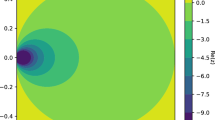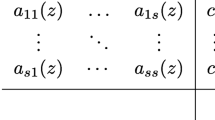Abstract
The standard approach to applying IRK methods in the solution of two-point boundary value problems involves the solution of a non-linear system ofn×s equations in order to calculate the stages of the method, wheren is the number of differential equations ands is the number of stages of the implicit Runge-Kutta method. For two-point boundary value problems, we can select a subset of the implicit Runge-Kutta methods that do not require us to solve a non-linear system; the calculation of the stages can be done explicitly, as is the case for explicit Runge-Kutta methods. However, these methods have better stability properties than the explicit Runge-Kutta methods. We have called these new formulas two-point explicit Runge-Kutta (TPERK) methods. Their most important property is that, because their stages can be computed explicity, the solution of a two-point boundary value problem can be computed more efficiently than is possible using an implicit Runge-Kutta method. We have also developed a symmetric subclass of the TPERK methods, called ATPERK methods, which exhibit a number of useful properties.
Zusammenfassung
Die standardmäßige Verwendung von impliziten RK-Verfahren zur Lösung von 2-Punkt Randwertproblemen erfordert für die Berechnung der Stufen die Lösung eines Systems vonn×s nichtlinearen Gleichungen, won die Anzahl der Differentialgleichungen unds die Stufenanzahl des impliziten RK-Verfahrens ist. Man kann jedoch für 2-Punkt Randwertprobleme eine Teilmenge der IRK-Verfahren auswählen, für die die Lösung von Gleichungssystemen nicht nötig ist; die Stufen können, wie bei expliziten RK-Verfahren, direkt berechnet werden. Trotzdem haben diese Verfahren bessere Stabilitätseigenschaften als explizite RK-Verfahren. Wir nennen diese neuen Formeln 2-Punkt explizite RK (TPERK)-Verfahren. Weil ihre Stufen explizit berechnet werden können, kann mit ihnen die Lösung eines 2-Punkt-Randwertproblems effizienter als mit einem impliziten RK-Verfahren berechnet werden. Wir beschreiben auch eine Unterklasse von symmetrischen TPERK-Verfahren, die ATPERK-Verfahren, die eine Reihe nützlicher Eigenschaften aufweisen.
Similar content being viewed by others
References
Ascher, U., Bader, G.: Stability of collocation at Gaussian points. To appear in SIAM J. Numer. Anal., 1986.
Ascher, U., Christiansen, J., Russel, R. D.: A collocation solver for mixed order systems of boundary value problems. Math. Comp.33, 659–679 (1979).
Ascher, U., Christiansen, J., Russel, R. D.: Collocation software for boundary value ODE's. ACM Trans. on Math. Software7, 209–222 (1981).
Ascher, U., Weiss, R.: Collocation for singular perturbation problems I: first order systems with constant coefficients. SIAM J. Numer. Anal.20, 537–557 (1983).
Ascher, U., Weiss, R.: Collocation for singular perturbation problems II: linear first order systems without turning points. Math. Comp.43, 157–187 (1984a).
Ascher, U., Weiss, R.: Collocation for singular perturbation problems III: nonlinear problems without turning points. SIAM J. Sci. Stat. Comp.5, 811–829 (1984b).
van Bokhoven, W. M. G.: Efficient higher order implicit one-step methods for integration of stiff differential equations. BIT20, 34–43 (1980).
Burrage, K.: A special family of Runge-Kutta methods for solving stiff differential equations. BIT18, 22–41 (1978).
Burrage, K., Butcher, J. C.: Stability criteria for implicit Runge-Kutta methods. SIAM J. Numer. Anal.16, 46–57 (1979).
Butcher, J. C.: Implicit Runge-Kutta Processes. Math. Comp.18, 50–64 (1964).
Butcher, J. C.: On the implementation of implicit runge-Kutta methods. Bit16, 237–240 (1976).
Cash, J. R.: A class of implicit Runge-Kutta methods for the numerical integration of stiff ordinary differential equations. J. Assoc. Comput. Mach.22, 504–511 (1975).
Cash, J. R., Moore, D. R.: A high order method for the numerical solution of two-point boundary value problems. BIT20, 44–52 (1980).
Cash, J. R., Singhal, A.: Mono-inplicit Runge-Kutta formulae for the numerical integration of stiff differential systems. IMA J. Numer. Anal.2, 211–227 (1982a).
Cash, J. R., Singhal, A.: High order methods for the numerical solution of two-point boundary value problems. BIT22, 184–199 (1982b).
Deuflhard, P., Bader, G.: Multiple shooting techniques revisited. Preprint No. 163, Institut für Angewandte Mathematik, University of Heidelberg, 1982.
England, R., Mattheij, R. M. M.: Boundary value problems and dichotomic stability. Boundary Value Problem Conference, Vancouver, B. C., July 1984.
Gupta, S.: An adaptive boundary value Runge-Kutta solver for first order boundary value problems. SIAM J. Numer. Anal.22, 114–126 (1985).
Kreiss, B., Kreiss, H. O.: Numerical methods for singular perturbation problems. SIAM J. Numer. Anal.18, 262–276 (1981).
Lentini, M., Pereyra, V.: IMSL Library Edition 9, IMSL Inc. Houston, Texas. Also: An adaptive finite difference solver for non-linear two-point boundary value problems with mild boundary layers. SIAM J. Numer. Anal.14, 91–111 (1977).
Muir, P.: Implicit Runge-Kutta methods for two-point boundary value problems. Ph. D. Thesis, Department of Computer Science, University of Toronto. Also Tech. Rep. 175/84, University of Toronto, 1984.
Ringhofer, C.: On collocation schemes for quasilinear singularly perturbed boundary value problems. SIAM J. Numer. Anal.21, 864–882 (1984).
Russell, R. D., Shampine, L. F.: A collocation method for boundary value problems. Numer. Math.19, 1–28 (1972).
Scherer, R., Türke, H.: Reflected and transposed methods. BIT23, 262–266 (1983).
Stetter, H. J.: Analysis of Discretization Methods for Ordinary Differential Equations. New York: Springer-Verlag 1973.
Varah, J. M.: On the efficient implementation of implicit Runge-Kutta methods. Math. Comp.33, 557–561 (1979).
Weiss, R.: The application of implicit Runge-Kutta and collocation methods to boundary value problems. Math. Comp.28, 449–464 (1974).
Wright, K.: Some relationships between implicit Runge-Kutta, collocation and Lanczos τ methods and their stability properties. BIT20, 217–227 (1970).
Author information
Authors and Affiliations
Additional information
This work was supported by the Natural Science and Engineering Research Council of Canada.
Rights and permissions
About this article
Cite this article
Enright, W.H., Muir, P.H. Efficient classes of Runge-Kutta methods for two-point boundary value problems. Computing 37, 315–334 (1986). https://doi.org/10.1007/BF02251090
Received:
Revised:
Issue Date:
DOI: https://doi.org/10.1007/BF02251090




